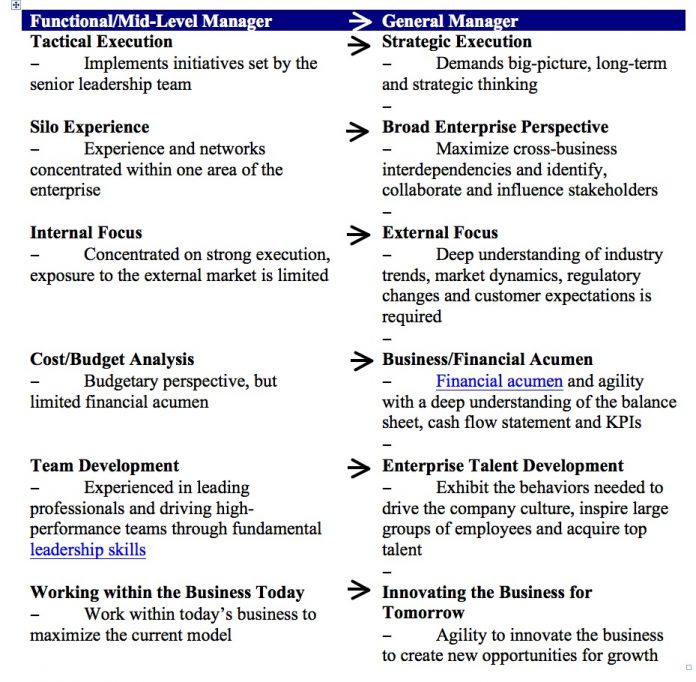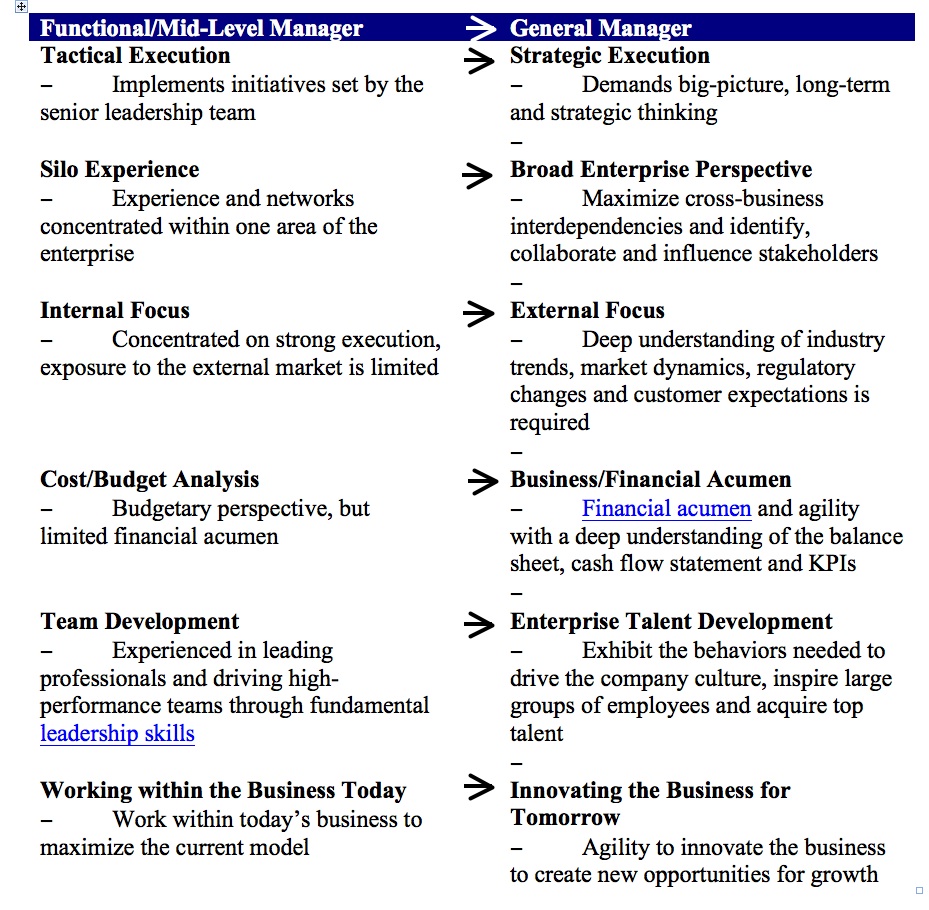
The lack of qualified talent to take on complex leadership roles in an environment of turbulence and change is a major challenge for leading companies.
A top private equity firm is acquiring companies each year but struggling to attract and appoint effective CEOs and business unit heads. A fast-growing technology enterprise is rapidly expanding its global operations, requiring senior leaders adept at leading international businesses. A mature industrial conglomerate is losing leaders to retirement and needs key talent to drive growth in the years ahead.
So where are all the general managers?
Root Causes: The Source of the General Manager Scarcity
As organizations evolved in the 1980s toward functional structures to increase efficiency, the focus shifted away from general management and toward divided silos and specialization within a segment of the company (Ron Ashkenas, “Bring Back the General Manager,” HBR Blog Network, Harvard Business Review, Jul. 18, 2012). Three decades later, we have become a society of specialists. Developing deep expertise in a specific field, many leaders have never been exposed to the full end-to-end enterprise.
As businesses become more volatile and markets more uncertain and interconnected, general management capabilities are needed now more than ever (Kyle Wiens, “In Defense of Polymaths,” HBR Blog Network, Harvard Business Review, Jul. 10, 2012). Reflecting this reality, over the last four years, the average number of general managers reporting directly to the CEO has increased by 81 percent (Carmen Nobel, “Crowded at the Top: The Rise of the Functional Manager,” Working Knowledge, Harvard Business Review, Mar. 12 2012).
However, as leaders are promoted into general manager roles, a strong track record and history of past achievements does not necessarily translate to success. Research reveals that 40 percent of high potentials promoted to the general management ranks fail (Employee Value Proposition Survey, Corporate Leadership Council, Human Capital Practice, 2009). As a general manager, leaders are challenged to evolve beyond their managerial focus, transition outside of their functional role, and rapidly grow their business skills to manage the greater scope in responsibility.
Navigating this transition is difficult. So what’s the best way to accelerate development and reduce the risk of failure?
Making the Jump from Functional, Mid-Level Management
In the past, a series of carefully identified stretch assignments would develop the skills and experiences needed to take on the general management challenges of the future. Over the course of 8 to 12 years, leaders would engage in rotational assignments, learn the role and make an impact—or in some cases, big mistakes. However, in today’s fast-paced and competitive environment, this development time frame is no longer viable.
If the 12-year timeline and past approach is no longer relevant, how can development be accelerated, and made more effective? To build the general managers of the future faster, we must simulate stretch assignments and challenges in immersive ways and condensed time frames.
Bridging the Skill Gap and Accelerating General Manager Development
To maximize impact, corporate development programs must move beyond the world of “curriculum” and evolve toward “designed experiences” in which talent leaders create and deliver frequent, immersive experiences with all the characteristics, challenges, and accountability of effective stretch assignments. Like a pilot in a flight simulator, business leaders can face real-world issues, execute new tasks, and perform new roles in different contexts and competitive market conditions. Through these high-impact, risk-free experiences, years of business exposure can be condensed, accelerated, and retained.
Integrated oil and gas company Chevron recognizes this opportunity. Understanding the development of high-potential leaders as critical to success, Chevron immerses leaders in a designed experience to maximize the impact of its Advanced Management Program.
Through a customized experiential learning program, leaders assume the roles of the senior leadership team responsible for the overall success of a simulated integrated oil company. Reflecting the company’s business, strategic priorities, and external factors, the decisions and trade-offs made by the participating leaders are real choices facing Chevron’s senior management. By engaging in the competitive business simulation, leaders learn great strategy implementation firsthand.
Nigel Hearne, vice president of Strategy (Downstream) at Chevron reflects on the experience: “The program enabled participants to think more strategically, broadened enterprise perspectives, built financial acumen, and provided an external focus and understanding of geopolitical decisions, competitive dynamics, and customer and investor expectations.”
For John Watson, Chevron’s chairman and CEO, the experiential learning program was a success. “I was skeptical at first about the value of the simulation, but I am now a strong believer in how much a simulation can provide a rich and efficient learning platform for our high-potential leaders.”
The Way Forward
For many organizations, general manager talent is not strong enough, the development pipeline is taking too long, and the leadership requirements are evolving so rapidly that the capabilities of today quickly become irrelevant.
To effectively design experiences that meet the demands of the business today, companies are best advised to address the following capability gaps:

Building these new skills and mindsets as leaders’ transition to the more senior ranks is not easy, but it is crucial to driving superior strategy execution and achieving business results. The need is great; the business benefits are significant; and success demands courageous, bold action.
Rommin Adl is an executive vice president and Global partner at BTS USA, Inc. He is responsible for implementing sales processes and marketing strategies throughout BTS Group and is a board member of BTS Digital.
Susan Burnett is the vice president of Leadership Development at BTS. With 30 years of talent and organization development experience at Yahoo!, Deloitte, Gap Inc., and Hewlett Packard Company, Burnett is helping clients build the talent management strategies they need to grow their people and grow the business.
Rich Dapra is the managing director of the Assessment Practice at BTS. An industry veteran of assessment center design and implementation in business and government, Dapra is responsible for establishing and growing the leadership assessment and selection practice.
For more information, visit http://www.bts.com/




